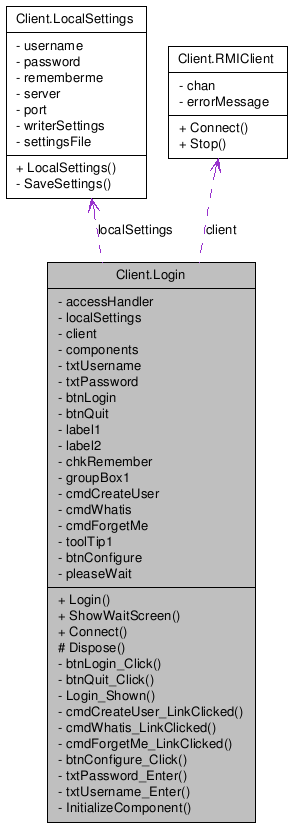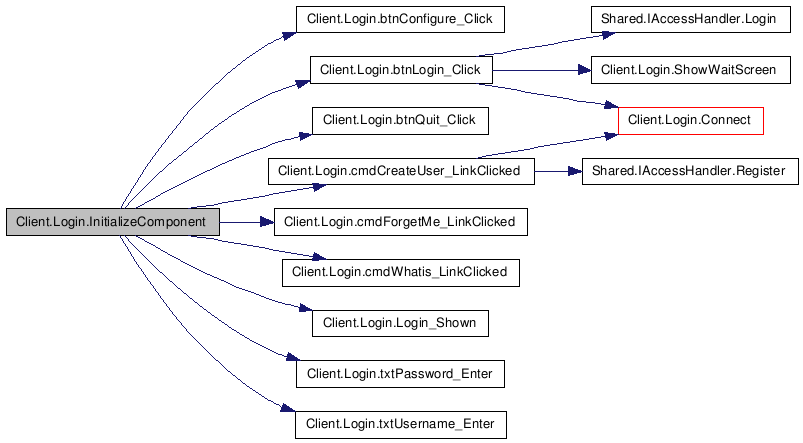
Collaboration diagram for Client.Login:

Public Member Functions | |
| Login () | |
| Login form constructor. | |
| void | ShowWaitScreen (bool toggle) |
| Used for showing the PleaseWait control. | |
| bool | Connect () |
| Connect to the RMI server defined by localSettings. | |
Protected Member Functions | |
| override void | Dispose (bool disposing) |
| Clean up any resources being used. | |
Private Member Functions | |
| void | btnLogin_Click (object sender, EventArgs e) |
| Perform the login function - also bound to the form's AcceptButton (meaning Enter logs in). | |
| void | btnQuit_Click (object sender, EventArgs e) |
| Quit the program - also bound to the form's CancelButton (meaning escape quits the program). | |
| void | Login_Shown (object sender, EventArgs e) |
| Make sure to highlight the username field upon first startup. | |
| void | cmdCreateUser_LinkClicked (object sender, LinkLabelLinkClickedEventArgs e) |
| Request creation of a new user. | |
| void | cmdWhatis_LinkClicked (object sender, LinkLabelLinkClickedEventArgs e) |
| Request some information on what the system is... | |
| void | cmdForgetMe_LinkClicked (object sender, LinkLabelLinkClickedEventArgs e) |
| Reset password and username to empty in localSettings, and empty out the information elsewhere... | |
| void | btnConfigure_Click (object sender, EventArgs e) |
| Show the configuration dialog. | |
| void | txtPassword_Enter (object sender, EventArgs e) |
| Highlights the contents of the password text field when you tab into it. | |
| void | txtUsername_Enter (object sender, EventArgs e) |
| Highlights the contents of the username field when you tab into it. | |
| void | InitializeComponent () |
| Required method for Designer support - do not modify the contents of this method with the code editor. | |
Private Attributes | |
| IAccessHandler | accessHandler |
| The access handler used by the system and passed on to the MainWindow upon login. | |
| LocalSettings | localSettings |
| Where to get the settings from (saved username...). | |
| RMIClient | client |
| The RMI client used by the access handler. | |
| System.ComponentModel.IContainer | components = null |
| Required designer variable. | |
| System.Windows.Forms.TextBox | txtUsername |
| System.Windows.Forms.TextBox | txtPassword |
| System.Windows.Forms.Button | btnLogin |
| System.Windows.Forms.Button | btnQuit |
| System.Windows.Forms.Label | label1 |
| System.Windows.Forms.Label | label2 |
| CheckBox | chkRemember |
| GroupBox | groupBox1 |
| LinkLabel | cmdCreateUser |
| LinkLabel | cmdWhatis |
| LinkLabel | cmdForgetMe |
| ToolTip | toolTip1 |
| Button | btnConfigure |
| SimpleControls.PleaseWait | pleaseWait |
Definition at line 16 of file Login.cs.
| Client.Login.Login | ( | ) |
Login form constructor.
Definition at line 28 of file Login.cs.
References Client.Login.chkRemember, Client.Login.cmdForgetMe, Client.Login.InitializeComponent(), Client.Login.localSettings, Client.LocalSettings.Password, Client.Login.pleaseWait, Client.Login.txtPassword, Client.Login.txtUsername, and Client.LocalSettings.Username.
Here is the call graph for this function:

| void Client.Login.btnLogin_Click | ( | object | sender, | |
| EventArgs | e | |||
| ) | [private] |
Perform the login function - also bound to the form's AcceptButton (meaning Enter logs in).
| sender | Who is calling? | |
| e | What arguments do they give us? |
Definition at line 53 of file Login.cs.
References Client.Login.accessHandler, Client.Login.chkRemember, Client.Login.client, Client.Login.Connect(), Client.Login.localSettings, Shared.IAccessHandler.Login(), Client.LocalSettings.Password, Client.Login.ShowWaitScreen(), Client.Login.txtPassword, Client.Login.txtUsername, and Client.LocalSettings.Username.
Referenced by Client.Login.InitializeComponent().
Here is the call graph for this function:

Here is the caller graph for this function:

| void Client.Login.btnQuit_Click | ( | object | sender, | |
| EventArgs | e | |||
| ) | [private] |
Quit the program - also bound to the form's CancelButton (meaning escape quits the program).
| sender | Who is calling? | |
| e | What arguments do they give us? |
Definition at line 126 of file Login.cs.
Referenced by Client.Login.InitializeComponent().
Here is the caller graph for this function:

| void Client.Login.Login_Shown | ( | object | sender, | |
| EventArgs | e | |||
| ) | [private] |
Make sure to highlight the username field upon first startup.
| sender | Who is calling? | |
| e | What arguments do they give us? |
Definition at line 136 of file Login.cs.
References Client.Login.txtUsername.
Referenced by Client.Login.InitializeComponent().
Here is the caller graph for this function:

| void Client.Login.ShowWaitScreen | ( | bool | toggle | ) |
Used for showing the PleaseWait control.
| toggle | True if you wish to show - False if you wish to hide it |
Definition at line 145 of file Login.cs.
References Client.Login.pleaseWait.
Referenced by Client.Login.btnLogin_Click().
Here is the caller graph for this function:

| bool Client.Login.Connect | ( | ) |
Connect to the RMI server defined by localSettings.
Definition at line 162 of file Login.cs.
References Client.Login.accessHandler, Client.Login.client, Client.RMIClient.Connect(), Client.RMIClient.ErrorMessage, and Client.RMIClient.Stop().
Referenced by Client.Login.btnLogin_Click(), and Client.Login.cmdCreateUser_LinkClicked().
Here is the call graph for this function:

Here is the caller graph for this function:

| void Client.Login.cmdCreateUser_LinkClicked | ( | object | sender, | |
| LinkLabelLinkClickedEventArgs | e | |||
| ) | [private] |
Request creation of a new user.
| sender | Who is calling? | |
| e | What arguments do they give us? |
Definition at line 187 of file Login.cs.
References Client.Login.accessHandler, Client.Login.Connect(), Shared.PersonInfo.department, Shared.PersonInfo.email, Shared.PersonInfo.name, Shared.PersonInfo.password, Client.UserForm.PersonInfo, Shared.IAccessHandler.Register(), Client.Login.txtPassword, Client.Login.txtUsername, and Shared.PersonInfo.username.
Referenced by Client.Login.InitializeComponent().
Here is the call graph for this function:

Here is the caller graph for this function:

| void Client.Login.cmdWhatis_LinkClicked | ( | object | sender, | |
| LinkLabelLinkClickedEventArgs | e | |||
| ) | [private] |
Request some information on what the system is...
| sender | Who is calling? | |
| e | What arguments do they give us? |
Definition at line 220 of file Login.cs.
Referenced by Client.Login.InitializeComponent().
Here is the caller graph for this function:

| void Client.Login.cmdForgetMe_LinkClicked | ( | object | sender, | |
| LinkLabelLinkClickedEventArgs | e | |||
| ) | [private] |
Reset password and username to empty in localSettings, and empty out the information elsewhere...
| sender | Who is calling? | |
| e | What arguments do they give us? |
Definition at line 231 of file Login.cs.
References Client.Login.chkRemember, Client.Login.cmdForgetMe, Client.Login.localSettings, Client.LocalSettings.Password, Client.Login.txtPassword, Client.Login.txtUsername, and Client.LocalSettings.Username.
Referenced by Client.Login.InitializeComponent().
Here is the caller graph for this function:

| void Client.Login.btnConfigure_Click | ( | object | sender, | |
| EventArgs | e | |||
| ) | [private] |
Show the configuration dialog.
| sender | Who is calling? | |
| e | What arguments do they give us? |
Definition at line 247 of file Login.cs.
References Client.Login.localSettings.
Referenced by Client.Login.InitializeComponent().
Here is the caller graph for this function:

| void Client.Login.txtPassword_Enter | ( | object | sender, | |
| EventArgs | e | |||
| ) | [private] |
Highlights the contents of the password text field when you tab into it.
| sender | Who is calling? | |
| e | What arguments do they give us? |
Definition at line 258 of file Login.cs.
References Client.Login.txtPassword.
Referenced by Client.Login.InitializeComponent().
Here is the caller graph for this function:

| void Client.Login.txtUsername_Enter | ( | object | sender, | |
| EventArgs | e | |||
| ) | [private] |
Highlights the contents of the username field when you tab into it.
| sender | Who is calling? | |
| e | What arguments do they give us? |
Definition at line 268 of file Login.cs.
References Client.Login.txtUsername.
Referenced by Client.Login.InitializeComponent().
Here is the caller graph for this function:

| override void Client.Login.Dispose | ( | bool | disposing | ) | [protected] |
Clean up any resources being used.
| disposing | true if managed resources should be disposed; otherwise, false. |
Definition at line 15 of file Login.Designer.cs.
References Client.Login.components.
| void Client.Login.InitializeComponent | ( | ) | [private] |
Required method for Designer support - do not modify the contents of this method with the code editor.
Definition at line 30 of file Login.Designer.cs.
References Client.Login.btnConfigure, Client.Login.btnConfigure_Click(), Client.Login.btnLogin, Client.Login.btnLogin_Click(), Client.Login.btnQuit, Client.Login.btnQuit_Click(), Client.Login.chkRemember, Client.Login.cmdCreateUser, Client.Login.cmdCreateUser_LinkClicked(), Client.Login.cmdForgetMe, Client.Login.cmdForgetMe_LinkClicked(), Client.Login.cmdWhatis, Client.Login.cmdWhatis_LinkClicked(), Client.Login.components, Client.Login.groupBox1, Client.Login.label1, Client.Login.label2, Client.Login.Login_Shown(), Client.Login.pleaseWait, Client.Login.txtPassword, Client.Login.txtPassword_Enter(), Client.Login.txtUsername, and Client.Login.txtUsername_Enter().
Referenced by Client.Login.Login().
Here is the call graph for this function:

Here is the caller graph for this function:

IAccessHandler Client.Login.accessHandler [private] |
The access handler used by the system and passed on to the MainWindow upon login.
Definition at line 19 of file Login.cs.
Referenced by Client.Login.btnLogin_Click(), Client.Login.cmdCreateUser_LinkClicked(), and Client.Login.Connect().
LocalSettings Client.Login.localSettings [private] |
Where to get the settings from (saved username...).
Definition at line 21 of file Login.cs.
Referenced by Client.Login.btnConfigure_Click(), Client.Login.btnLogin_Click(), Client.Login.cmdForgetMe_LinkClicked(), and Client.Login.Login().
RMIClient Client.Login.client [private] |
The RMI client used by the access handler.
Definition at line 23 of file Login.cs.
Referenced by Client.Login.btnLogin_Click(), and Client.Login.Connect().
System.ComponentModel.IContainer Client.Login.components = null [private] |
Required designer variable.
Definition at line 9 of file Login.Designer.cs.
Referenced by Client.Login.Dispose(), and Client.Login.InitializeComponent().
 1.5.1-p1
1.5.1-p1